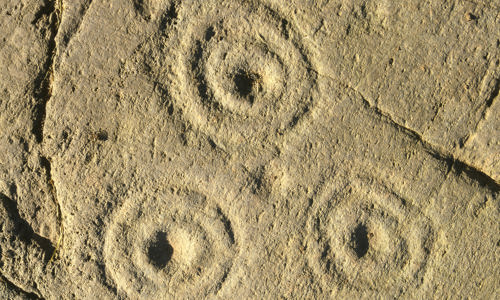History
The complexity of the decoration at Cairnbaan varies between outcrops. Carved motifs include:
- cups and cup and ring marks on all outcrops
- deep grooves on the eastern group
- conjoined multiple-ringed cups in the western group
- a broad, shallow cup with a single ring and a series of rays in the western group
The Cairnbaan carvings are characterised by the deeply carved channels or gutters running from cup-marks through rings, or wandering across the rock-face. Similar carvings appear at nearby Kilmichael Glassary.
What do the symbols mean?
We can only speculate about the meanings Kilmartin Glen’s Neolithic inhabitants attached to these markings. The carvings are abstract and contain no animal or human figures.
It’s been argued that the rock art should be regarded as a series of messages with meanings dependent on their landscape. Complex carvings, like those at Cairnbaan usually occur near lowland sites, while carvings on higher ground tend to be more simple.
A prehistoric landscape
A rich prehistoric landscape survives in Kilmartin Glen, providing a tantalising insight into its prehistoric population. The surviving rock art along the glen is remarkable for the number of elaborately carved outcrops, the style of and extent of the carvings, and their close association with other prehistoric monuments. No other place in Scotland has such a concentration of prehistoric carved stone surfaces, and Neolithic and Bronze Age monuments.
Other carved rock outcrops around Kilmartin Glen include:
Other monuments include:
- Dunadd Hill Fort
- Dunchraigaig Cairn
- Glebe Cairn
- Nether Largie North Cairn
- Nether Largie Mid Cairn
- Nether Largie South Cairn
- Ri-Cruin Cairn
- Temple Wood Stone Circle
The glen is also home to an important collection of medieval sculptured stones.









